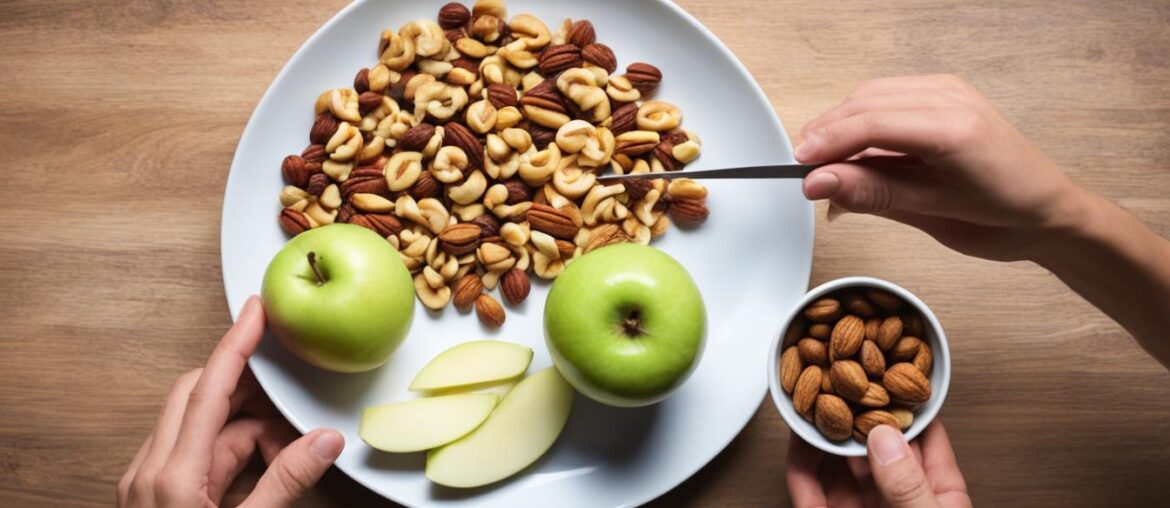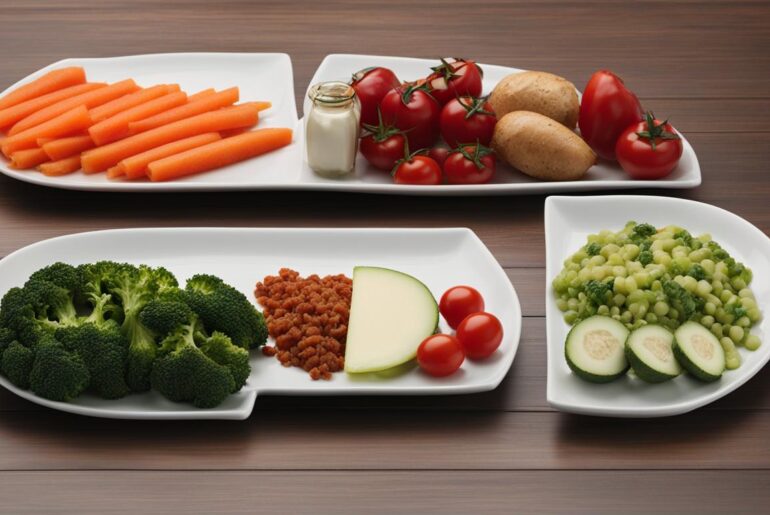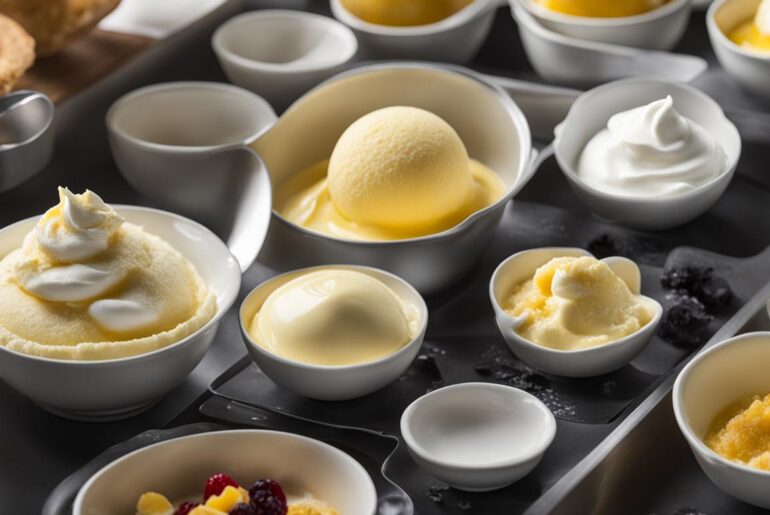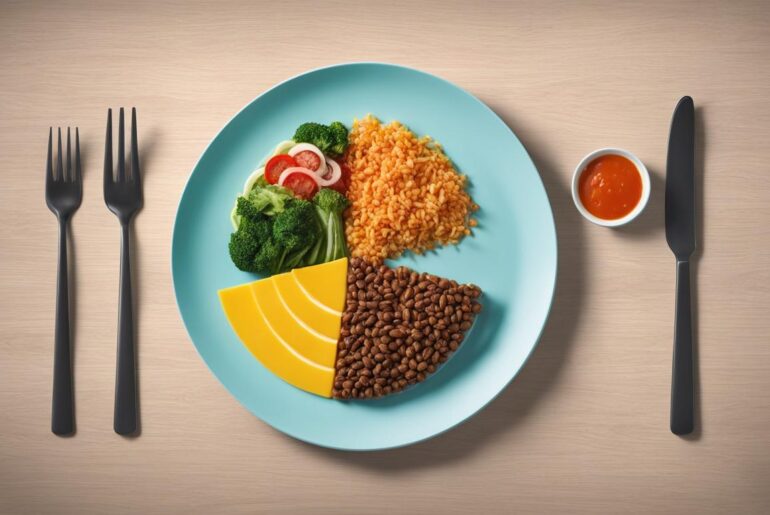Portion control is a vital aspect of maintaining a healthy diet and managing weight. In this article, I will share three highly effective portion control practices that I recommend. By implementing these practices, you can learn how to control portion sizes and make healthier choices for a more balanced lifestyle.
Managing portion sizes plays a significant role in achieving your health goals. It can help prevent overeating, maintain a healthy weight, and promote overall well-being. Let’s explore these three effective portion control practices:
Key Takeaways:
- Using a smaller plate can visually trick you into thinking you have a full plate, preventing overloading and promoting portion control.
- Measuring your portions with measuring cups can ensure that you consume the appropriate amount of food consistently.
- Choosing healthier options for seconds, such as fruits or low-calorie alternatives, can help you fill up without consuming excessive calories.
- Checking food labels can provide valuable information about portion sizes and nutritional content.
- Being mindful when eating out and choosing smaller portions or sharing dishes can help you maintain portion control goals.
Use a Smaller Plate
One effective way to practice portion control is to use a smaller plate. When we use a larger plate, a standard-sized portion appears small, leading us to feel unsatisfied and potentially overeat. By opting for a smaller plate, we can visually trick ourselves into thinking we have a full plate, preventing overloading and controlling our portions more effectively. This simple yet powerful strategy can make a significant difference in managing portion sizes (check this post out).
Using a smaller plate helps create the illusion of a substantial meal, even with a smaller portion. When we see a full plate, our brain perceives it as a satisfying meal, promoting feelings of satiety. By preventing the habit of overloading our plates with excess food, we can prevent overeating and maintain better control over our portion sizes.
Research suggests that using a smaller plate can lead to a reduction in calorie intake and aid in weight management. A study published in the International Journal of Obesity found that individuals who used smaller plates consumed fewer calories compared to those who used larger plates.
Here is a comparison of portion sizes on a standard dinner plate and a smaller plate:
| Standard Dinner Plate | Smaller Plate | |
|---|---|---|
| Protein | 8 oz (227 g) chicken breast | 6 oz (170 g) chicken breast |
| Grains | 2 cups (360 g) cooked rice | 1.5 cups (270 g) cooked rice |
| Vegetables | 2 cups (360 g) steamed broccoli | 1.5 cups (270 g) steamed broccoli |
As you can see, simply reducing the plate size can lead to a significant decrease in portion sizes without sacrificing satisfaction. By using a smaller plate, we can prevent overloading and implement portion control strategies effortlessly (check this post out).
In addition to using a smaller plate, incorporating other portion control techniques such as measuring your portions with measuring cups, being selective with seconds, and checking food labels can further support your efforts in practicing portion control effectively (check this post out).
Measure your Portions with Measuring Cups
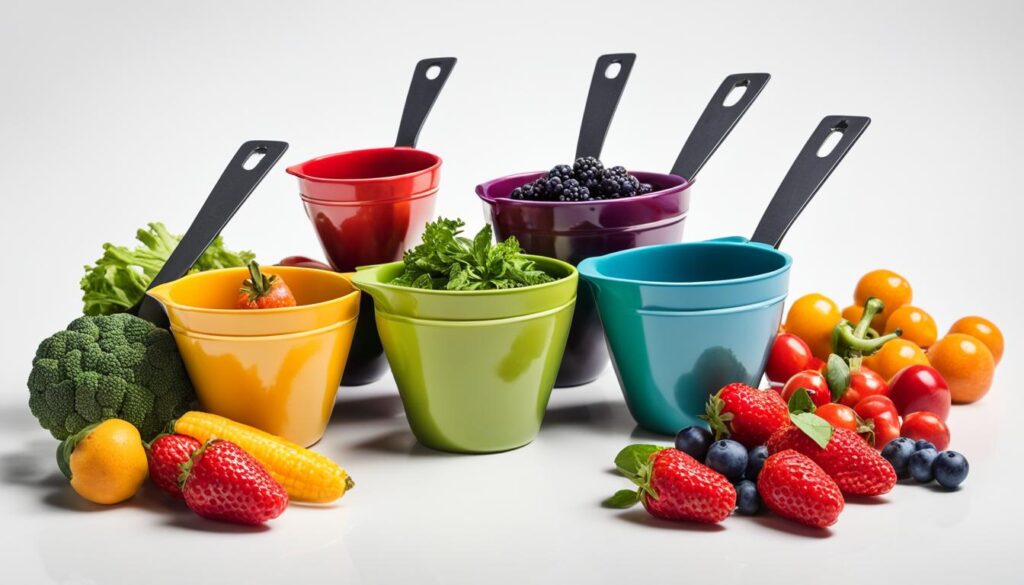
If you find it challenging to gauge the right amount to eat, using measuring cups can be a helpful tool. By measuring your portions, you can ensure that you are consuming the appropriate amount of food. You can use regular cups or containers that work for you, making it a simple and practical way to control your portions consistently. Measuring cups can aid in developing mindful eating habits and promoting portion control best practices.
When it comes to portion control, accuracy is key. Measuring cups provide a precise way to measure your food portions, eliminating guesswork and promoting mindful eating. By using measuring cups, you can easily keep track of your portion sizes, ensuring that you are not overeating or underestimating your calorie intake (check out my post on using measuring cups here).
Here are some tips on effectively using measuring cups for portion control:
- Invest in a set of quality measuring cups. Look for cups with clear measurements marked on the inside and a variety of sizes to accommodate different food types.
- Use the appropriate sized cup for each food group. For example, use a 1-cup measuring cup for grains, a ½-cup measuring cup for fruits and vegetables, and a ¼-cup measuring cup for nuts and seeds.
- When measuring liquids, use a liquid measuring cup with a pour spout for accuracy. Be sure to measure at eye level to avoid any miscalculations.
- When measuring solid food, fill the cup without packing it tightly. Level off the excess with a straight edge, such as a knife or spatula, for precise measurements.
- If you don’t have measuring cups on hand, you can use everyday objects as a reference. For example, one cup is roughly the size of a baseball, half a cup is similar to a small fist, and a quarter cup is approximately the size of a golf ball.
Using measuring cups not only helps you control your portion sizes but also trains your eyes to recognize appropriate portions visually. Over time, you may develop a better sense of portion sizes and be able to estimate servings more accurately, even without the measuring cups.
Benefits of Using Measuring Cups for Portion Control
Using measuring cups for portion control can have numerous benefits, including:
- Preventing overconsumption: Measuring cups allow you to accurately portion out your meals, preventing you from overeating.
- Aiding in weight management: By controlling your portion sizes, you can better manage your calorie intake and support your weight loss or maintenance goals.
- Promoting a balanced diet: Measuring cups help you maintain a balance between different food groups, ensuring you get a variety of nutrients in appropriate proportions.
- Providing consistency: When you measure your portions consistently, it becomes easier to track your food intake and make adjustments if needed.
- Creating mindful eating habits: Measuring cups encourage you to pay attention to your food and savor each bite, promoting mindful eating practices.
By incorporating measuring cups into your portion control routine, you can take control of your eating habits and make more informed choices about your food intake. Remember, precise portion control is an effective tool for achieving and maintaining a healthy lifestyle.
| Food Group | Recommended Portion Size |
|---|---|
| Grains (pasta, rice, cereal) | 1 cup |
| Fruits and Vegetables | ½ cup |
| Dairy (milk, yogurt) | 1 cup |
| Protein (meat, fish, tofu) | 3 ounces |
| Nuts and Seeds | ¼ cup |
Be Selective with Seconds
When it comes to maintaining portion control, being selective with seconds is key. It’s tempting to indulge in calorie-dense desserts or snacks when there’s food leftover, but making healthier choices can help you stay on track. Opt for nutrient-dense options like fruits or low-calorie alternatives instead. By choosing these healthier options, you can satisfy your cravings and fill yourself up without consuming excessive calories.
Being mindful of your choices when it comes to seconds is an effective strategy for portion control and maintaining a healthy weight. By practicing selective eating, you can balance your diet and ensure that you’re getting the right amount of nutrients while keeping calorie intake in check.
Examples of Selective Second Choices:
- Fresh fruits and berries
- Low-calorie yogurt or Greek yogurt
- Lightly salted or air-popped popcorn
- Nuts and seeds
- Vegetable sticks with hummus
These options are not only satisfying but also bring a variety of flavors and textures to your meals. Keep in mind that portion sizes still matter, even when choosing healthier options. Practice self-control and be mindful of your eating habits to ensure you’re making the most of your portion control efforts.
Summary:
Being selective with seconds is a powerful portion control strategy that allows you to enjoy your meals without overindulging (check out my post on portion control strategy here). By opting for healthier choices and avoiding calorie-dense options, you can maintain a healthy weight and achieve your wellness goals. Remember, it’s all about making smart choices that nourish your body while still enjoying the foods you love.
| Benefits of Being Selective with Seconds: |
|---|
| Helps maintain a healthy weight |
| Reduces calorie intake |
| Promotes balanced and nutritious meals |
| Allows for occasional indulgence without guilt |
Check Food Labels
When it comes to portion control, one valuable resource is food labels. These labels provide essential information about portion sizes, helping you make informed decisions about what and how much to eat.
Understanding the nutrition information on the front of a food package is crucial in aligning it with your portion control goals. By paying attention to serving sizes and nutritional content, you can ensure you stay within your dietary needs and maintain a healthy lifestyle.
Food labels typically include details such as calories, fat content, carbohydrates, protein, and serving sizes. It’s important to note that serving sizes on food labels may differ from the portions you typically serve yourself. Always refer to the serving size mentioned on the label to ensure accurate portion control.
By using food labels as a guide, you can make better decisions about your portion sizes and create a more balanced meal plan. Whether you’re managing your weight or trying to make healthier choices, checking food labels is an effective practice for portion control best practices.
“Understanding the nutrition information on food labels empowers you to take control of your portion sizes and make informed choices.”
Example Food Label:
| Nutrition Facts | Amount per serving |
|---|---|
| Serving size: 1 cup (240g) | |
| Calories: 150 | |
| Total Fat: 10g | |
| Carbohydrates: 15g | |
| Protein: 4g |
Table: Example food label showcasing serving size, calories, fat content, carbohydrates, and protein per serving.
Be Mindful of Eating Out
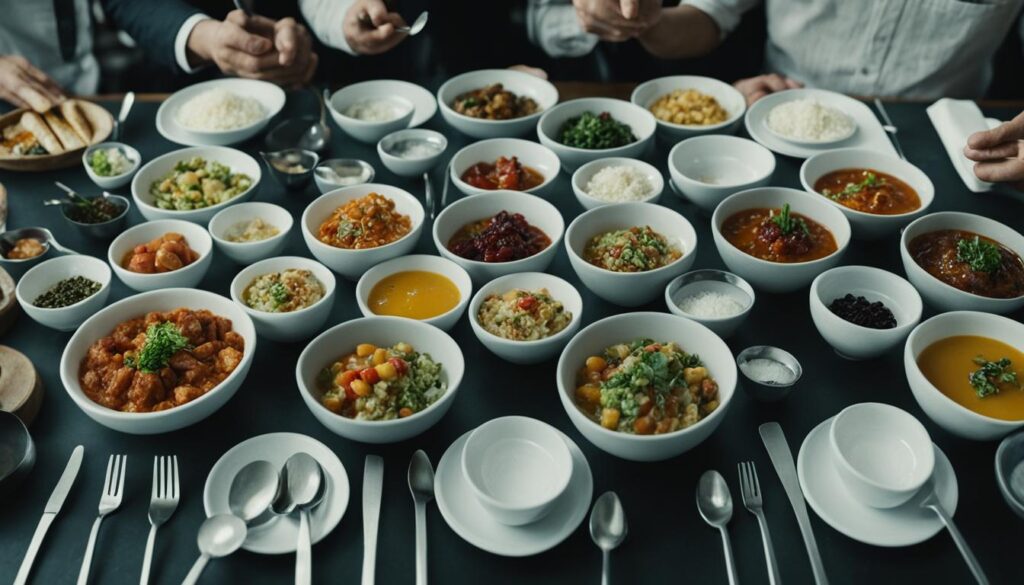
When dining out, it is crucial to be mindful of portion sizes and avoid falling into the trap of oversized servings. Many restaurants serve larger portions than what is considered a healthy serving size. To practice portion control while eating out, you can employ the following strategies:
- Ask for a half portion: Don’t hesitate to inquire if the restaurant offers smaller portion sizes. Most establishments are accommodating and will gladly reduce the amount served.
- Share a dish with a friend: Sharing a meal is an excellent way to control portion sizes while enjoying a variety of flavors. Splitting an entrée can also save you money.
- Choose items from the appetizer or children’s menu: These menus often have smaller-sized portions, making them ideal for practicing portion control. You can also opt for healthier options from these menus.
By being proactive and aware of portion sizes when dining out, you can maintain your portion control goals even in social settings.
| Portion Control Tips for Eating Out |
|---|
| Ask for a half portion |
| Share a dish with a friend |
| Choose items from the appetizer or children’s menu |
Drink Water Before Meals
One simple and effective way to practice portion control is by drinking water before meals. Water can help you feel fuller and reduce your overall food intake. By hydrating your body before eating, you can distinguish between true hunger and thirst, preventing overeating. Research has shown that drinking water before meals can lead to a decrease in calorie intake and potentially aid in weight management.
When you drink water before a meal, it can help create a sense of fullness in your stomach, making you less likely to overeat during the meal. Additionally, water has no calories, so it can be a great alternative to high-calorie beverages like soda or juice, which can contribute to excess calorie consumption.
“Drinking water before meals has been found to reduce calorie intake, which can ultimately support weight management and portion control goals.”
In a study published in the journal Obesity, researchers found that participants who drank 500ml of water before each main meal consumed fewer calories during the meal compared to those who didn’t drink water before eating. This simple habit of drinking water before meals can be a powerful tool in managing portion sizes and promoting a healthier eating pattern.
The Benefits of Drinking Water Before Meals
- Enhances feelings of fullness
- Reduces calorie intake
- Supports weight management
Incorporating the habit of drinking water before meals can not only aid in portion control but also contribute to overall hydration and well-being. By making it a part of your routine, you can set yourself up for success in managing your portion sizes and achieving your health goals.
| Portion Control Technique | Description |
|---|---|
| Drink Water Before Meals | Hydrating your body before meals can help you feel fuller and reduce your overall food intake. |
| Use a Smaller Plate | Opting for a smaller plate can visually trick you into thinking you have a full plate, preventing overloading and controlling portions more effectively. |
| Measure your Portions with Measuring Cups | Using measuring cups can ensure that you are consuming the appropriate amount of food, promoting mindful eating and portion control best practices. |
Conclusion
Implementing effective portion control techniques is crucial for maintaining a healthy weight and promoting overall well-being. By incorporating healthy portion control methods into your daily routine, you can take control of your portion sizes and achieve a more balanced lifestyle (check this post out).
Start by using a smaller plate, which can help prevent overloading and visually trick your mind into feeling satisfied with smaller portions. Measuring your food with measuring cups is another great practice that ensures you’re consuming the appropriate amount of food, promoting mindful eating and portion control.
Being selective with seconds is essential in maintaining portion control. Opt for nutrient-dense options, such as fruits or low-calorie alternatives, instead of calorie-dense desserts or snacks. Additionally, checking food labels can provide valuable information about serving sizes and nutritional content, enabling you to make informed decisions about your diet.
When dining out, be mindful of portion sizes and consider sharing a dish with a friend, asking for a half portion, or choosing items from the appetizer or children’s menu. Furthermore, drinking water before meals can help you feel fuller and reduce overall food intake, aiding in portion control and weight management.
By adhering to these portion control practices consistently and remaining mindful of your eating habits, you can achieve your health goals and maintain long-term success in managing your portion sizes.

